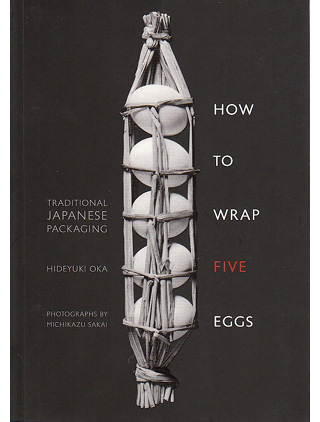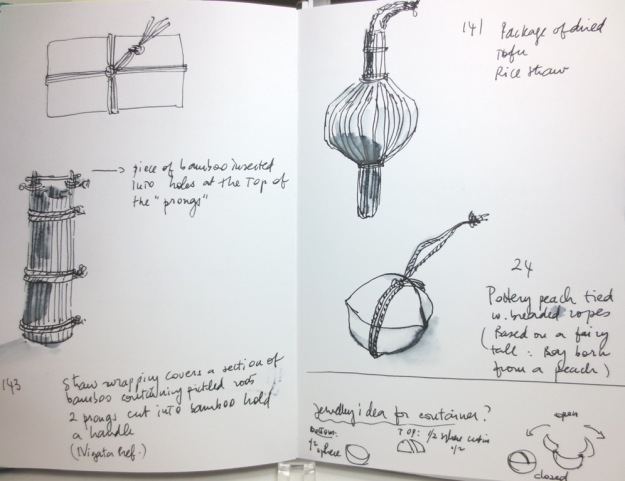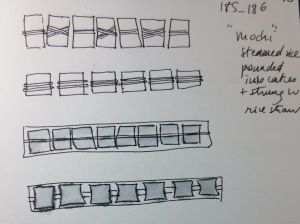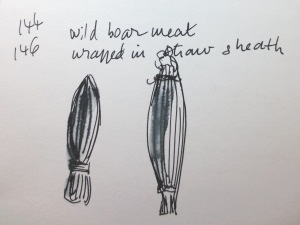
How to Wrap Five Eggs – Traditional Japanese Packaging, by Hideyuki Oka. Photographs by Michikazu Sakai.
For years, I lugged around a dog-eared copy of “How to Wrap Five Eggs”, a coffee-table size book from my local library. Knowing that it was both out of print and unaffordable, I made dozens of drawings from the gorgeous black and white illustrations so that I could revisit them and mine them for ideas later (until I had received too many angry reminders from the library, and had to reluctantly return the book). I found everything I was looking for, and much more: timeless designs, both practical and beautiful.
Hideyuki Oka (1905-1995), a renowned Japanese graphic designer, collected traditional Japanese packaging and his collections were regularly exhibited around the world. A book featuring over 200 traditional objects from his collection, with illustrations by Michikazu Sakai, and commentaries by Oka, was published in 1967. A second edition came out in 1975 under the title “How to Wrap Five More Eggs”. These are pricey, oversized books, with gorgeous black and white photographs, that, as I said, are unfortunately out of print. However, in 2008, Shambhala Publications reissued the second book inexplicably under the title of the first book “How to Wrap Five Eggs”. As a paperback, it is now quite affordable, and also, thankfully, much easier to lug around!
When searching for inspiration and new ideas, I always prefer to look at other mediums. By avoiding jewellery, I am more likely to come up with less predictable, fresher ideas. Also, I find that most design solutions can be translated from one medium to another. This book is an excellent tool for the design process. It shows what makes a “good” design – a balanced relationship between beauty and function.
(Above) A package of dried tofu slices made of rice straw. It reminds me of the lavender potpourris my grandmother would make every year at the end of the summer. The bundle of long-stemmed flowers was tied tightly together, then bent onto itself to keep the flowers on the inside. A silk ribbon was threaded through to keep it from breaking and spilling its contents on the linens. Simple, but effective.
(Above) Tofu and “mochi” (steamed rice) pounded into cakes and strung with rice straw. Can be hung from the ceiling and used as needed. Ordinary, everyday products are beautifully and elegantly packaged. The strong graphic lines of the straw create a very pleasing rhythmical pattern.
(Above) Basic packages made from natural materials and designed to carry, store and preserve various food items. Palm leaf, and a sheath of straw.
(Above) Sampling of food from a restaurant in Tokyo wrapped in an unadorned package – except for the elaborate knots of the straw rope. This was meant to be given as a gift. It is quite understated, but done with great care and consideration. According to Oka, “What is the use of a package if it shows no feeling?”
(Above) A section of bamboo covered with straw, used as a container for pickled roots of mountain burdock. Rustic looking, but its shape is perfectly suited for the long roots of burdock. The handle is a small piece of bamboo inserted into holes pierced into two prongs protruding from the bamboo tube – a simple, but elegant solution that could be easily translated into metal.
(Above) Container for candies, from Okayama Prefecture. Pottery in the shape of a peach tied with braided ropes. The design is based on the fairy tale of Momotaro, the boy born from a peach. The bottom part of the container is a half-sphere; the top is made of two domed sections. This is another design that could be adapted to metalwork, for a small locket or a larger scale vessel, with a lid articulated on hinges.
What I have presented in this post is a small sampling of what can be found in Oka’s book. In this selection, I chose to focus mostly on simple packages made with everyday natural materials, whatever was at hand, like straw, leaves and bamboo. “How to Wrap Five Eggs” offers many more examples of wrappers, boxes, baskets and various containers, some more intricate or less rustic, and using clay, paper, wood or fabric. Regardless of the choice of materials, no matter how humble they might be, the craftsmanship is always exquisite; whatever the technique (ceramics, wood carving, basketry, etc.), every piece shows a careful attention for the simplest of details, as well as ingenuity and creativity. These are valuable lessons on how to apply smart, elegant solutions to design challenges; timeless in that they can still be applied today, even with modern materials.
I will leave you with one final quote by Hideyuki Oka : “… what we have lost for sure is what this book is about: a once-common sense of fitness in the relationships between hand, material, use, and shape, and above all, a sense of delight in the look and feel of very ordinary, humble things.”
“How to Wrap Five Eggs – Traditional Japanese Packaging”
By Hideyuki Oka. Photographs by Michikazu Sakai. Weatherhill, an imprint of Shamhala Publications, Inc., 2008. ISBN 978-1-59030-619-2








The book sounds wonderful – I love your story about keeping it out of library for several years.
: ) Wonderful sketches!
Yes, a classic, and so good, I became a library delinquent because of it…
Now you know I’ll do anything in the name of art.
Thank you Karen!
Love your sketeches and the source! I was just struggling with some design issues yesterday and love the idea of moving right out of metal to get your inspiration! As always, Dominique, timely and inspirational. 🙂
It’s so great to hear from you, Donna!
How are you? What projects are you working on? I would love to see what what you’ve been making.
Thank you for your kind comments.
Dominique, what an inspiring read! I think it’s so wonderful how you borrowed this book and sketched such detailed little gems of beauty. When we borrowed books (particularly when in college) – my peers and I ran directly to the photocopy machine and only sketched what was essential. I have “dog- eared” pages in my sketchbooks from the university where I photocopied illustrations, then rubber-cemented them onto the pages. I did not sketch anything w/ the beauty and caliber of your beautiful drawings here. As usual, a very enjoyable post!!
Thank you so much, Patricia. I am glad you enjoyed it.
And, I’d love to know what your favorite design books are!
Great post Dominique! Couldn’t agree more that inspiration needs to come from both within, but particularly from outside your chosen medium. I’ve always found that comics, costumes, sculpture and architecture work well for me. I will definitely look up this book. I haven’t looked yet, but I am betting the burnaby library system probably has it. The metrotown library is an excellent resource for art books. Better, I find, then downtown. But don’t tell anybody!
Darren,
Thanks for the tip about the library. I have taken out most of the books on jewellery in the downtown library.
Robert
Thank you Darren. It’s so good to hear from you!
Do you remember this amazing book on Alexander Calder you brought to the class? (must have been a Burnaby library find!). That was quite inspiring. True, it is jewellery, but Calder being a sculptor had such a different approach to making jewellery – and probably more so because he was trained as an engineer originally. I loved that he did not often use solder, preferring cold connections instead and finding so many creative ways of joining the various parts of his designs. Deceptively simple.
And thanks for telling us about the Burnaby library (looks like Robert may have ransacked it already).
Yeah, I loved that book on Calder’s jewellery. He seemed to approach jewellery as more of a blacksmith than a silversmith, with interesting, inspiring results. I do think that cold connections are under appreciated and love his work for that. Indeed it was a Metrotown library find!
I should say, however, that while their jewellery section is good (I have a few in my possession here on holiday) their painting section is second to none in my experience.
Blacksmith – yes, I totally agree. His approach was more muscular for sure. And dynamic. He understood metal and knew how to make it move and curl under the hammer. Very inspiring.
Thank you Darren!
Hi Dominique,
I just read your last post and one entry was very pertinent.
There was a documentary on the exquisite gardens of Provence with its fields
of lavender. In one scene, there was an older woman showing two teenagers
how to bind lavender. They tied 19 stalks with a satin ribbon, then bent
all the blossoms backward over the ribbon, then wove the ribbon in and out
of the stalks. It enclosed all the blossoms and made a sachet. The package looked very much like the Wild Boar Meat one. Intriguing.
and timely.
Robert
Hi Robert! Thank you so much for your comments on the lavender sachets from Provence – your description is so much clearer and accurate than mine. It shows how universal these designs are – I guess because they are so well adapted to their function, and so beautiful as well.
My grand-mother, who was from Poitou, not from Provence, used to call them “fuseaux” (spindles), but I believe the word “épis” (ears) is used too.
*(My apologies – I posted this as a reply to someone else’s earlier comment by mistake! Feel free to delete the one I posted above)*
This was one of the most inspirational reads I have come across in a while. I absolutely adore your sketches and the details you provided from the book (especially on the importance of feeling/emotion in the wrapping/presentation) were absolutely fascinating. This is definitely a post I will be sharing with others!
What H. Oka said about “feeling” being important in traditional Japanese packaging and how it is “a sort of sacred ritual” really resonated with me as well.
Thank you for your comments, Samantha!
This is truly fantastic, with your permission, I would like to share/ re-blog this. I have some fellow bloggers, and fellow facebook and metalsmithing friends who I am sure would love your post as much as I just did.
Please do! I’d love to hear what other artists/metalsmiths think of this amazing book.
Thank you for your interest.